I have a player sprite
class Player(pygame.sprite.Sprite):
def __init__(self):
pygame.sprite.Sprite.__init__(self)
self.movex = 0
self.movey = 0
self.frame = 0
self.images = []
for i in range(1,5):
img = pygame.image.load(os.path.join('assets/player', 'run-' + str(i) + '.png')).convert_alpha()
self.images.append(img)
self.image = self.images[0]
self.rect = self.image.get_rect()
def control(self,x,y):
self.movex += x
self.movey += y
def update(self):
self.rect.x = self.rect.x + self.movex
self.rect.y = self.rect.y + self.movey
And some boundaries I want to clamp them to
self.boundaries = [ [[(475,350),(575,350),(500,550),(300,550)],],
[[(0,0),(100,100),(200,200)]],
[[(0,0),(100,100),(200,200)]],
]
So far the player sprite can be clampled on to the display surface rect correctly but how would I clamp onto a dynamic polygon with the player sprite rect.
self.stages.level=0
self.stages_boundary_index=0
##self.stages.player.rect.clamp_ip(pygame.display.get_surface().get_rect())
#Detection between sprite and a boundary
"""
x = self.stages.boundaries[self.stages.level][self.stages.boundary_index]
print(x)
elem=Rect(x[0],x[1],x[2],x[3])
self.stages.player.rect.clamp_ip(elem)
"""
Edited: Tried this but it looks like the boundaries are shifted a bit.
def collideLineLine(l1_p1, l1_p2, l2_p1, l2_p2):
# normalized direction of the lines and start of the lines
P = pygame.math.Vector2(*l1_p1)
line1_vec = pygame.math.Vector2(*l1_p2) - P
R = line1_vec.normalize()
Q = pygame.math.Vector2(*l2_p1)
line2_vec = pygame.math.Vector2(*l2_p2) - Q
S = line2_vec.normalize()
# normal vectors to the lines
RNV = pygame.math.Vector2(R[1], -R[0])
SNV = pygame.math.Vector2(S[1], -S[0])
RdotSVN = R.dot(SNV)
if RdotSVN == 0:
return False
# distance to the intersection point
QP = Q - P
t = QP.dot(SNV) / RdotSVN
u = QP.dot(RNV) / RdotSVN
return t > 0 and u > 0 and t*t < line1_vec.magnitude_squared() and u*u < line2_vec.magnitude_squared()
def colideRectLine(rect, p1, p2):
return (collideLineLine(p1, p2, rect.topleft, rect.bottomleft) or
collideLineLine(p1, p2, rect.bottomleft, rect.bottomright) or
collideLineLine(p1, p2, rect.bottomright, rect.topright) or
collideLineLine(p1, p2, rect.topright, rect.topleft))
def collideRectPolygon(rect, polygon):
for i in range(len(polygon)-1):
if colideRectLine(rect, polygon[i], polygon[i+1]):
return True
return False
class Player(pygame.sprite.Sprite):
def __init__(self):
pygame.sprite.Sprite.__init__(self)
self.movex = 0
self.movey = 0
self.frame = 0
self.images = []
for i in range(1,5):
img = pygame.image.load(os.path.join('assets/player', 'run-' + str(i) + '.png')).convert_alpha()
self.images.append(img)
self.image = self.images[0]
self.rect = self.image.get_rect()
def control(self,x,y):
self.movex += x
self.movey += y
def update(self,boundary):
if self.movex > 0:
self.image = self.images[self.frame//ani]
if self.movey !=0:
if collideRectPolygon(self.rect, boundary):
self.rect.x+=self.movex
self.rect.y+=self.movey
else:
self.rect.x-=self.movex
self.rect.y-=self.movey
self.movex=0
self.movey=0
else:
if collideRectPolygon(self.rect, boundary):
self.rect.x+=self.movex
else:
self.rect.x-=self.movex
self.movex=0
elif self.movex < 0:
self.image = pygame.transform.flip(self.images[self.frame // ani], True, False)
if self.movey !=0:
if collideRectPolygon(self.rect, boundary):
self.rect.x+=self.movex
self.rect.y+=self.movey
else:
self.rect.x-=self.movex
self.rect.y-=self.movey
self.movex=0
self.movey=0
else:
if collideRectPolygon(self.rect, boundary):
self.rect.x+=self.movex
else:
self.rect.x-=self.movex
self.movex=0
else:
self.image = self.images[self.frame//ani]
if self.movey !=0:
if collideRectPolygon(self.rect, boundary):
self.rect.y+=self.movey
else:
self.rect.y-=self.movey
self.movey=0
else:
pass
